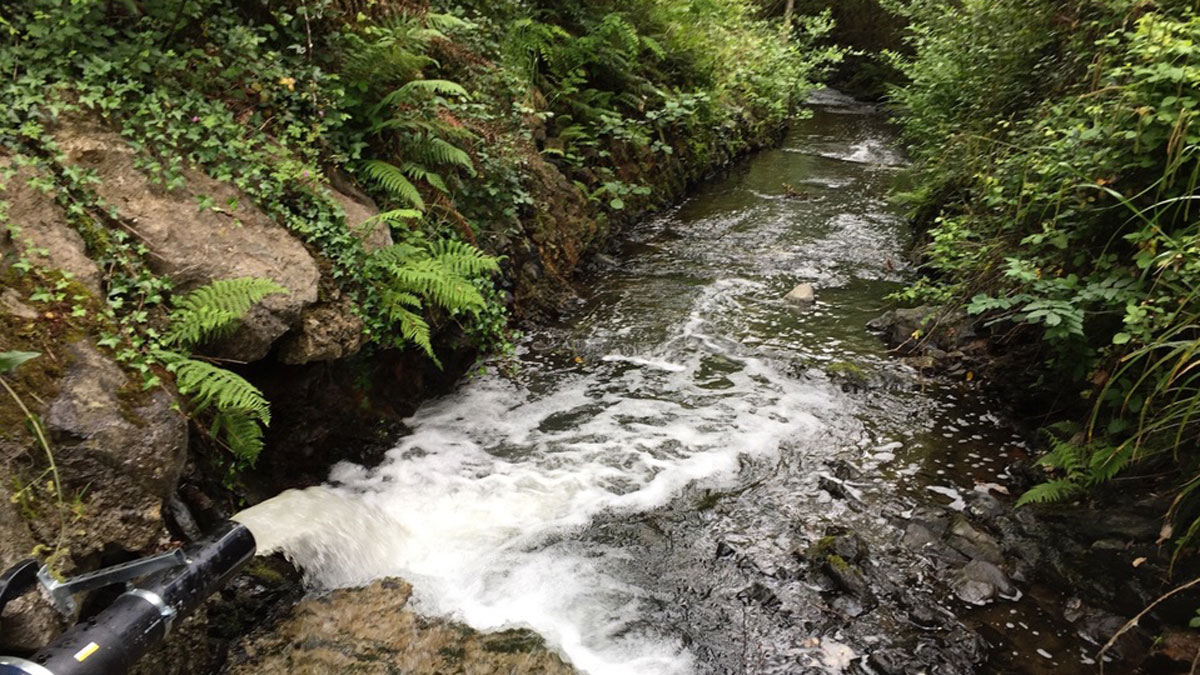Rivers are awash with excess nutrients, chemicals, and other pollutants, including sewage. Globally, roughly 50% of wastewater is treated at facilities before being released into nearby bodies of water. But new research shows that even advanced treatment might not be enough to safeguard the health of freshwater ecosystems.
Researchers released dilute, treated wastewater into an unpolluted stream in northern Spain and made a before and after comparison of energy flows through the ecosystem.
“We found subtle yet fundamental shifts in ecosystem function.”
“We found subtle yet fundamental shifts in ecosystem function after adding wastewater,” said Ioar de Guzman, a freshwater ecologist at the University of the Basque Country in Spain and lead author of the study. By manipulating a pristine ecosystem, she and her colleagues could isolate the effects of wastewater, which can be masked in streams that contain other types of water pollution.
Agricultural runoff, containing nitrogen-rich fertilizer, is a familiar blight, causing lurid green algal blooms that choke aquatic life.
“Wastewater is probably a bigger stressor to river functioning than agriculture,” said Mario Brauns, a freshwater ecologist from the Helmholtz Centre for Environmental Research in Germany who works on food web analysis with de Guzman but was not involved with the new study.
Besides nitrogen and other nutrients, sewage is laced with an insidious cocktail of toxic contaminants derived from cleaning and beauty products, pharmaceuticals, and more.
Decades of investment to reduce wastewater pollution, driven by legislation such as the European Water Framework Directive and the U.S. Clean Water Act, show that treatment can significantly improve water quality. But, de Guzman said, “even after advanced treatment, toxic compounds and nutrients still remain.”
In their experiment, de Guzman and colleagues used wastewater from a large treatment facility near Elgoibar, northern Spain, which employs physical and biological processing, involving separation tanks and microbial digestion, for example, and advanced screening to remove extra nutrients and metals.
Aftereffects
Ecological impact assessments are often conducted after a wastewater treatment plant has been established, using sites upstream to gauge conditions without the facility. But these control points might not accurately reveal what wastewater does to a stream because the water can already be degraded, Brauns explained. Isolating the effects of each pollution source would be nearly impossible.
To look at the role of wastewater, de Guzman and colleagues first studied an unpolluted stream in good ecological condition. They split the stream into two sections and, over the course of a year, inventoried the entire ecosystem in each.
Starting at the base of the food web, they recorded the amount of leaf litter and biofilm—a mix of algae, organic material, and fungi that coats a streambed. They then counted and measured the invertebrates that fed on those resources and, finally, the fish at the top of the food web. During the following year, they surveyed each stream section again, after channeling wastewater into only the downstream reach.
Biodiversity counts such as these are the cornerstone of ecological impact assessments, but the researchers also wanted to define ecosystem health. They did this by quantifying how much energy was produced and consumed at different tiers of the feeding network.
The team calculated the amount of energy supplied as leaf litter and biofilm and how much of each was eaten depending on the biomass, body mass, and metabolic rate of each species. By comparing the path of energy flowing from each resource before and after diverting wastewater, the researchers could attribute any changes to wastewater pollution.
“This energy flow is the beating pulse of our ecosystems. Measuring that energy gives us a valuable metric of ecosystem health.”
“This energy flow is the beating pulse of our ecosystems,” said Amy Rosemond, an aquatic ecosystem ecologist from the University of Georgia who was not involved in the study. “Measuring that energy gives us a valuable metric of ecosystem health,” she said.
The increase in nutrients should stimulate biofilm growth, priming higher levels of the food web with extra energy, de Guzman said. As expected, the amount of biofilm increased after the wastewater was introduced. In turn, invertebrates ate more biofilm and less leaf litter.
The surprise, de Guzman said, was that the amount of energy flowing to the fish did not increase. She said she thinks changes to the invertebrate community (with pollution-resistant species becoming more dominant) could be responsible. But she would need more data on the fishes’ diets and energy demands before saying for certain. These results were published in the Journal of Environmental Management.
“This is an interesting ecological surprise,” Rosemond said. “We know that nutrient pollution can decouple the predator-prey relationship.” Having extra food of a certain type benefits some species, she explained, but those organisms aren’t necessarily the most palatable food for predators, so that extra energy can remain untapped.
Cumulative Effects
“This is a clever way to disentangle wastewater impacts from other pollution sources,” said Sujay Kaushal, a hydrochemist from the University of Maryland who was not involved in the study. The results show that after much investment in advanced wastewater treatment, there is still room for improvement, he added.
There is no single solution to wastewater pollution, Brauns said, although the best place to start is by limiting what gets into our waterways in the first place. Aside from wastewater pollution, our rivers face a barrage of human threats as they flow past cities and agricultural areas.
Point source wastewater pollution can be regulated, but diffuse inputs such as runoff from agricultural land and roads can be harder to trace and attribute. These pollution sources can merge—amplifying the overall effect on water quality. “Now we need to find out how these combined stressors impact ecosystem function,” Brauns said.
Source : Eos.





Add Comment